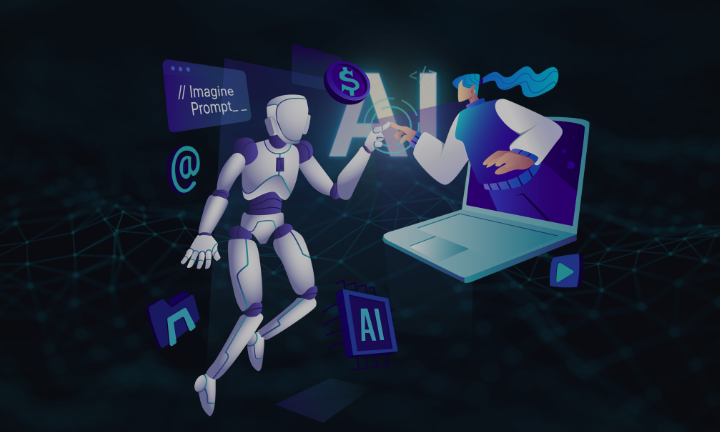Imagine your workday as a cluttered desk. Papers pile high, tasks blur together, and the ever-present feeling of being behind looms large. Now imagine a magic assistant who sorts your documents, automates repetitive tasks, and surfaces the most important information – that’s the power of AI in your workflow.
According to a McKinsey report [ Source: McKinsey Global Institute, “A future that works: Automation, employment, and productivity,”], up to 800 million jobs globally could be automated by 2030. But don’t panic! AI isn’t here to replace you – it’s here to empower you.
Intrigued by the potential of AI to transform your software development company ? We’ve got you covered. This blog dives deep into the top 6 AI workflow automation tools, helping you declutter your digital desk and become a productivity powerhouse.
Step-by-step approach to harnessing the power of AI and boosting your workflow:
Step 1: Identify Repetitive Tasks:
Start by analyzing your daily routine. Pinpoint tasks that feel monotonous and time-consuming, eating away at your productivity. These could be tasks like scheduling meetings, data entry, email filtering, or social media posting.
Step 2: Start Small and Experiment:
Begin by implementing AI automation for a single, well-defined task. This allows you to get comfortable with the technology and understand its capabilities. Once you’re confident, gradually automate additional tasks.
Step 3: Train and Integrate the Tools:
Find an AI tool which resonates with the needs & goals of your needs and tasks, act accordingly. Most AI tools require training data to function effectively. Provide the tool with relevant examples and data points to ensure accurate automation.
Connect your AI tools with the existing apps and software you use daily. This streamlines your workflow and allows for a smooth flow of information.
Step 4: Monitor and Optimize:
Keep an eye on how AI automation is performing. Are tasks being completed accurately and efficiently? AI is an evolving technology. Don’t be afraid to fine-tune your tools and adapt your workflows as needed.
Bonus Step: Embrace the Change!
With AI handling repetitive tasks, you’ll have more time to focus on higher-level cognitive tasks. Use this newfound freedom to delve into creative problem-solving, strategic planning, and activities that contribute significantly to your success.
Top 6 AI Workflow Automation Tools
1. AI21 Labs:
- Features: Offers a suite of AI tools including Jurassic-1 Jumbo, a factual language model, and Jarvis, a creative text-format generation tool.
- Future: Focus on developing specialized LLMs for various industries and tasks. Potential for offering more user-friendly interfaces and tools for non-technical users.
2. Cohere:
- Features: Offers a variety of pre-trained LLMs including for summarization, question answering, and code generation.
- Future: Emphasis on building industry-specific LLMs and expanding user base beyond developers. Potential for offering more user-friendly interfaces and pre-built applications.
3. Stability.ai:
- Features: Open-source platform for developing and deploying text-to-image AI models like Dall-E 2.
- Future: Continued development of generative AI models with a focus on photorealism and controllability. Potential for integration with design and animation software.
4. Paradigm by LightOn:
- Features: Offers a large factual language model called Megatron-Turing NLG.
- Future: Limited information available on future plans. Potential for focusing on enterprise applications of factual language models.
5. AWS Bedrock
- Features: Access to Leading Foundation Models (FMs), Simplified Development Experience, Model Customization and Retrieval Augmented Generation (RAG), Built-in Security, Privacy, and Safety:
- Future: Integration with more advanced AI models and capabilities. Broader adoption of responsible AI practices within the platform.
6. Azure AI Studio
- Features: Low-code/no-code AI development, pre-trained models & APIs, collaborative workspace;
- Future: Democratizes AI development, fosters responsible AI practices.
Don’t Get Left Behind: Invest in AI Workflow Automation
The benefits of AI workflow automation are undeniable: increased efficiency, skyrocketing productivity, seamless scalability, and a significant boost to your ROI. These intelligent platforms streamline processes, minimize errors, and give you a crucial competitive edge in today’s fast-paced market.
Investing in AI isn’t just about reaping immediate benefits; it’s about future-proofing your business. Innovation in AI is accelerating, and companies that embrace AI integration now will be well-positioned to thrive as this technology continues to revolutionize workflows. Don’t wait until AI becomes the industry standard – be a leader, not a follower. Embrace AI workflow automation and watch your business soar ahead of the competition.
FAQs
What is AI workflow?
The AI workflow refers to the entire process of bringing AI solutions from concept to real-world application within an organization. It’s like a recipe for building successful AI projects, with each stage contributing to a valuable and impactful outcome.
What are the 4 stages of an AI workflow?
- Data Preparation: This crucial stage involves collecting, cleaning, and organizing the data that will be used to train the AI model. It ensures the quality and relevance of the data for accurate learning.
- Model Design and Training: Here, data scientists design the AI model architecture and train it on the prepared data. This involves selecting algorithms, tuning parameters, and iteratively improving the model’s performance.
- Evaluation and Testing: Once trained, the AI model is rigorously evaluated to assess its accuracy, robustness, and potential biases. This stage ensures the model performs well on unseen data and delivers reliable results.
- Deployment and Monitoring: Finally, the validated AI model is deployed into production for real-world use. This stage involves integrating the model with existing systems, monitoring its performance, and making adjustments as needed.
How many enterprises use AI?
Current Adoption Rate: According to a recent study by IBM, 34% of companies currently use AI in their business operations (as of 2024).
Exploration and Future Adoption: However, the picture goes beyond just current users. Exploding Topics reports that an additional 42% of companies are exploring AI, meaning they are actively researching, planning, or piloting AI initiatives. This brings the total number of companies engaged with AI (either using or exploring) to over 77%.


